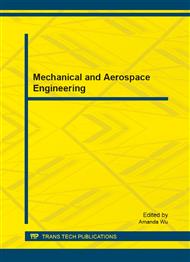p.414
p.419
p.427
p.432
p.437
p.445
p.450
p.456
p.461
Localization and Identification of Vibroacoustic Sources of Gear Transmission Mechanism by Inverse Frequency Response Function
Abstract:
Our contribution in this work is to detect, localize and quantify the noise sources radiated by a spur gear transmission mechanism. The imaging technique is used; it is based on the acoustic inverse frequency response function (IFRF). The IFRF is based on the inversion of the transfer matrix built between the source points represented by their complex source strengths and listening points represented by the complex pressures measured by the hologram. The measurements were performed in a semi-anechoic room where the floor is concrete and the walls are covered with glass wool. The complex acoustic pressures are measured by an antenna with microphones regularly spaced; it is placed above the noisy mechanism. The reconstruction problem is therefore an inverse problem and is said ill-posed; thus, regularizations are needed to stabilize and to find the best solutions. As regularization technique, the Tikhonov method is applied and the regularization parameters are chosen according to the L-curve method. The goal is to reconstruct as accurately as possible the acoustic field radiated by the transmission mechanism on a fictive and tangent plane to the noisy mechanism considered open and sometimes closed. The results obtained showed that the sources were located with good approximation. The IFRF method is able to reconstruct the sound sources responsible for the noise radiated by the mechanism without any a priori information of the sources distribution, and the visualization of spatial acoustic fields facilitate the understanding of the complex phenomena of radiation.
Info:
Periodical:
Pages:
437-444
Citation:
Online since:
November 2012
Authors:
Keywords:
Price:
Сopyright:
© 2012 Trans Tech Publications Ltd. All Rights Reserved
Share:
Citation:


